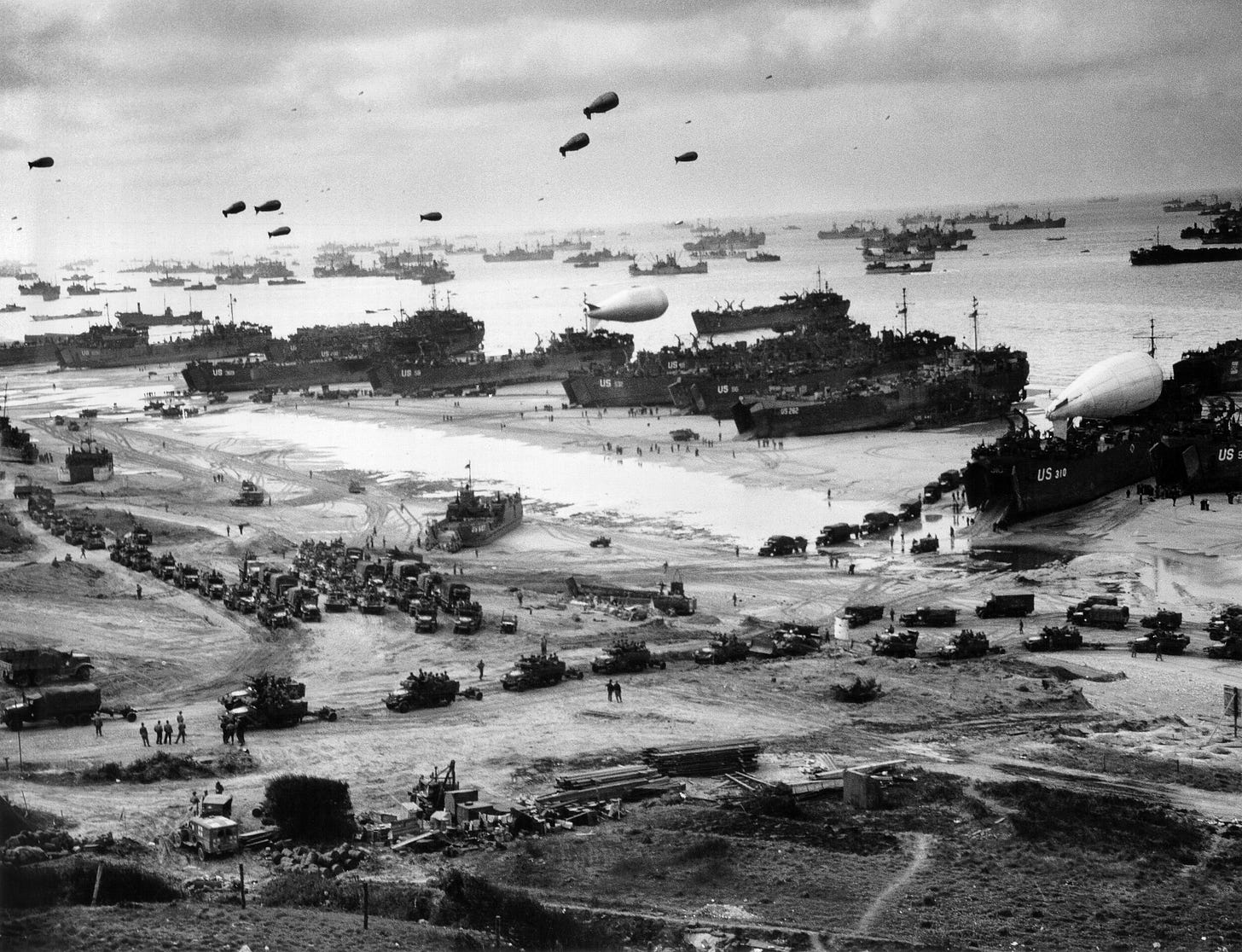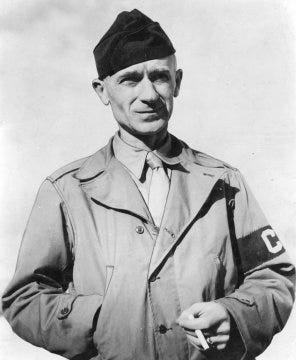The legendary World War II correspondent Ernie Pyle was on the flotilla of boats that launched from England and stormed the coast of France at Normandy on D-Day, June 6, 1944. In researching my book, one of the most moving tasks was to read first-hand accounts of the war, and Pyle’s was the best, a combination of no-nonsense, detailed reporting and empathetic observation. I want to share his account of the D-Day landing, quoting passages from his book “Brave Men.”
Pyle had been in the Italian campaigns, and in fact wrote about being atop Monte la Difensa, my father’s first big battle, at the bitterly cold fight for San Pietro, and on the flat plains of Anzio for the liberation of Rome. As I tried to look over my father’s shoulder to see what he saw, I found another writer already there. Pyle’s accounts were pivotal to my understanding of what the soldiers went through.
From Italy, Pyle went to the south of France, then on to England, where he was one of 28 correspondents (out of 450) invited to take part in the “assault phase.” The Assault Correspondents didn’t know when it would happen or which unit they’d be assigned to. They got a pack of field equipment, inoculations and briefings. And they waited. Finally, with 90 minutes’ notice, they were called to go, and traveled south from London.
“There we drew our final battle kit—such things as clothing impregnated against gas attack, a shovel to dig foxholes, seasickness capsules, a carton of cigarettes, a medical kit, and rations.” The rest of their gear had been packed and sent on ahead. If the Army’s incredible logistics worked, they would be reunited with it once they had landed in France.
Pyle was woken at 4 a.m. and told they would move at dawn. The correspondents were assigned to units and nervously said goodbye to each other, shaking hands and saying “Take it easy.” Pyle rode with the convoy commander as they headed for the coast. The roads were empty, with military police at every crossing and people waving from their homes.
By dusk they reached their transport, an LST, Army shorthand for “Landing Ship, Tank.” Right after they boarded the boxy vessel, “already nearly loaded with trucks and armored cars and soldiers,” it cast off.
“That evening, the colonel commanding the troops on our ship gave me the whole invasion plan in detail—the secret the whole world had waited years to hear. Once a man had heard it he became permanently a part of it. Then he was committed. It was too late to back out, even if his heart failed him.”
Pyle interviewed the commander. “I realized my voice was shaking when I spoke but I couldn’t help it.” Yes, the colonel said, there would be casualties.
“From a vague anticipatory dread the invasion now turned into a horrible reality to me. In a matter of hours the holocaust of our own planning would swirl over us. No man could guarantee his own fate. It was almost too much for me. A feeling of utter desperation obsessed me throughout the night. It was nearly 4 a.m. before I got to sleep, and then it was a sleep harassed and torn by an awful knowledge.”
His ship was in the middle of a convoy of LSTs. “Each of us towed a big steel pontoon section, these to be used as barges and docks in the shallow waters along the beach. And behind each pontoon we towed a smaller pontoon with two huge outboard motors on it—a thing called a “rhino.” The pontoons and the rhinos broke free of some of the ships, some of the LSTs themselves broke down, and Pyle knew it was certain death in the icy English Channel waters if his ship sank.
“All of us had dreaded the trip, for we had expected attacks from U-boats, E-boats, and at nighttime from aircraft. Yet nothing whatever happened.”
The water was “crammed with forces going both ways” in miles-wide channels swept clear of mines and marked with buoys.
“There we were in a front-row seat at a great military epic.”
“As far as you could see in every direction the ocean was infested with ships. There must have been every type of oceangoing vessel in the world. I even thought I saw a paddlewheel steamer in the distance, but that was probably an illusion.
“There were battleships and all other kinds of warships clear down to patrol boats. There were great fleets of Liberty ships. There were fleets of luxury liners turned into troop transports, and fleets of big landing craft and tank carriers and tankers. And in and out through it all were nondescript ships—converted yachts, river boats, tugs, and barges.
“The best way I can describe that vast armada and the frantic urgency of the traffic is to suggest that you visualize New York Harbor on its busiest day of the year and then just enlarge that scene until it takes in all the ocean the human eye can reach, clear around the horizon. And over the horizon, imagine dozens of times that many.”
The assault was “magnificently organized, and every ship, even the tiniest one, was always under exact orders timed to the minute.” So when his LST arrived ahead of schedule, it had to weave in and out of the convoy for hours before they got their turn to land.
“That was when the most incongruous—to us—part of the invasion came. There we were in a front-row seat at a great military epic. Shells from battleships were whamming over our heads, and occasionally a dead man floated face downward past us. Hundreds and hundreds of ships laden with death milled around us. We could stand at the rail and see both our shells and German shells exploding on the beaches, where struggling men were leaping ashore, desperately hauling guns and equipment through the water.

“We were in the very vortex of the war—and yet, as we sat there waiting, Lieutenant Chuck Conick and I played gin rummy in the wardroom and Bing Crosby sang ‘Sweet Leilani’ over the ship’s phonograph.
“Angry shells hitting near us would make heavy thuds as the concussion carried through the water and struck the hull of our ship. But in our wardroom men in gas-impregnated uniforms and wearing life belts sat reading Life and listening to the BBC telling us how the war before our eyes was going.
“But it wasn’t like that ashore. No, it wasn’t like that ashore.”
Pyle’s group did not arrive on the beaches until the morning after D-Day, after the fighting had moved inland. The beach where they landed was littered with wreckage and lined with bodies of soldiers, and he saw the “intense, grim determination of work-weary men to get that chaotic beach organized and get all the vital supplies and the reinforcements moving more rapidly over it from the stacked-up ships standing in droves out to sea.”
“After it was over it seemed to me a pure miracle that we ever took the beach at all. For some of our units it was easy, but in the special sector where I landed our troops faced such odds that our getting ashore was like my whipping Joe Louis down to a pulp. The men who did it on that beach were men of the First and Twenty-ninth Divisions.
“I want to tell you what the opening of the second front in that one sector entailed, so that you can know and appreciate and forever be humbly grateful to those both dead and alive who did it for you.
“Ashore, facing us, were more enemy troops than we had in our assault waves. The advantages were all theirs, the disadvantages all ours. The Germans were dug into positions they had been working on for months, although they were not entirely complete. A 100-foot bluff a couple of hundred yards back from the beach had great concrete gun emplacements built right into the hilltop. These opened to the sides instead of to the front, thus making it hard for naval fire from the sea to reach them. They could shoot parallel with the shore and cover every foot of it for miles with artillery fire.
“Then they had hidden machine gun nests on the forward slopes, with crossfire taking in every inch of the beach. These nests were connected by networks of trenches, so that the German gunners could move about without exposing themselves.
“Throughout the length of the beach, running zigzag a couple of hundred yards back from the shore line, was an immense V-shaped ditch fifteen feet deep. Nothing could cross it, not even men on foot, until fills had been made. And in other places at the far end of the beach, where the ground was flatter, they had great concrete walls. These were blasted by our naval gunfire or by explosives set by hand after we got ashore.
“Our only exits from the beach were several swales or valleys, each about a hundred yards wide. The Germans made the most of those funnellike traps, sowing them with buried mines. They also contained barbed-wire entanglements with mines attached, hidden ditches, and machine guns firing from the slopes.
“All this was on the shore. But our men had to go through a maze nearly as deadly before they even got ashore. Underwater obstacles were terrific. Under the water the Germans had whole fields of evil devices to catch our boats. Several days after the landing we had cleared only channels through them and still could not approach the whole length of the beach with our ships. Even then some ship or boat would hit one of those mines and be knocked out of commission.
“The Germans had masses of great six-pronged spiders—made of railroad iron and standing shoulder-high—just beneath the surface of the water, for our landing craft to run into. They had huge logs buried in the sand, pointing upward and outward, their tops just below the water. Attached to the logs were mines.
“In addition to these obstacles they had floating mines offshore, land mines buried in the sand of the beach, and more mines in checkerboard rows in the tall grass beyond the sand. And the enemy had four men on shore for every three men we had approaching the shore.
“And yet we got on.”
Ernie Pyle (1900-1945) was a Pulitzer Prize-winning war correspondent. He worked as managing editor of The Washington Daily News and later became a roving journalist for Scripps-Howard Alliance. After many years following the fighting in Europe, he traveled to the South Pacific, where a sniper’s bullet ended his life. (Bio from the Penguin Classics version of “Brave Men.”)




